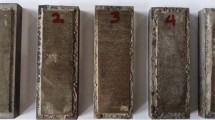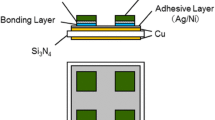Abstract
This paper aims to study the effects of different brazing temperatures and holding time on the exposing height of the brazing diamond and wetting angle of the solder, and to analyze the morphology and composition of the reaction products at the interface between the diamond and the solder. Using the Ni-Cr-B-Si composite solder, the orderly arrangement method, the flame spraying process, and the remelting technology–based vacuum carbon tube furnace, the sample block with single layer ordered diamond is prepared. The results show that with the increasing of brazing temperature, the exposing height of the diamond, and the wetting angle of the solder decrease, and with the increasing of holding time, the exposing height of the diamond increases, and the wetting angle of the solder decreases. In addition, the fine acicular Cr-C compounds are formed at the brazing interface between diamond and solder, which prevents the increasing of wetting capacity of solder. The study of the effects of brazing temperature and holding time on the brazing quality, and the analysis of the morphology and composition of the products in the brazing interface, provide important technical and theoretical support for the better production of brazing diamond tools.













Similar content being viewed by others
References
Lei L, Tian XL, Wang L, Wang WL (2016) Research progress of mechanical processing technology of engineering ceramics. Journal of Ceramics 37(5):460–464
Ma CG, Shi XH (2015) A discussion on the current status and development trend of diamond tool. Superhard Mater Eng 27(5):45–48
Zhou YM, Zhang JZ, Lv Z, Chen GX (2003) Research and development of high temperature brazing diamond tools. Welding Technology 32(5):1–4
Xuan QQ, Long WM, Zhang HH, Zheng DX, Zhang QK (2017) Research progress of brazed monolayer diamond abrasive tools. Electric Welding Machine 47(3):22–26
Wu M, Cao CZ, Rafi-ud-din H, X B, Qu XH (2013) Brazing diamond/Cu composite to alumina asing reactive Ag-Cu-Ti Alloy. Trans Nonferrous Metals Soc China 23(6):1701–1708
Jiang ZP, Meng P, Wang JR (2017) Influence of Ni-Cr alloy on morphology and mechanical properties of brazed diamond grits. Hot Working Technology 46(9):221–223
Duan DZ, Xiao B, Wang W, Zhang ZY, Wang B, Han P, Ding XY (2015) Interface characteristics and performance of pre-brazed diamond grains with Ni-Cr composite alloy. J Alloys Compd 644:626–631
Sung CM (2001) Brazed diamond tools by infiltration, United State Patent No. US6193770B1, Taipei
Ding LY (2014) Research on fabrication and application technology of the self-lubricating multilayer brazed diamond tools, Doctoral thesis, Nanjing University of Aeronautics and Astronautics
Lin ZD (2004) Manufacturing technology of brazed single-layer diamond tools, Diamond&Abrasives Engineering, Serial. 141.No.3, pp.1–5
Xiang ZS (2012) Research on brazing process of fine-grained diamond abrasive, Master's thesis, Nanjing University of Aeronautics and Astronautics
Xiao CJ, Li J, Li ZX (2015) Effect of Cr on wettability and holding force in AI/diamond system. Dia&Abra Eng 35(2):33–36
Guan YC (2005) Research on brazing method of diamond grinding disc. Stone (6):28–32
Lu JB, He YX, Zhang WX, Liu L, Li H (2016) Vacuum brazing diamond with Ni-Cr-B-Si+Cu-P-Sn composite filler metal. Chin J of Nonferrous Met 26(3):610–615
Lu JB, Xu JH (2007) Morphology of carbide on diamond Interface by vacuum brazing. Chin J of Nonferrous Met 17(7):1143–1148
Yao ZJ, Xu HJ, Xiao B, Wu ZB (2001) Micro-analysis of Interface between Ni-Cr alloy and diamond. J Nanjing U Aeronaut& Astronautics 33(4):312–314
Acknowledgements
We are grateful to Xue Yahong for useful discussions. We thank Zou Juan, Jiao Xiaochen, Li Na, and Liu Changxin for experimental support.
Author information
Authors and Affiliations
Corresponding author
Additional information
Publisher’s note
Springer Nature remains neutral with regard to jurisdictional claims in published maps and institutional affiliations.
Recommended for publication by Commission XVII - Brazing, Soldering and Diffusion Bonding
Rights and permissions
About this article
Cite this article
Chen, J., Wang, X., Li, X. et al. Effects of brazing temperature and holding time on wettability of brazing diamond and brazing interface analysis. Weld World 64, 1763–1770 (2020). https://doi.org/10.1007/s40194-020-00954-8
Received:
Accepted:
Published:
Issue Date:
DOI: https://doi.org/10.1007/s40194-020-00954-8




